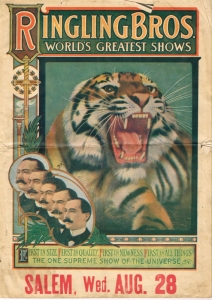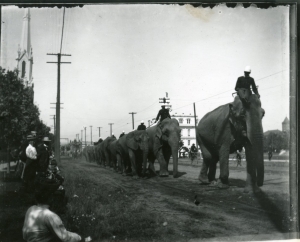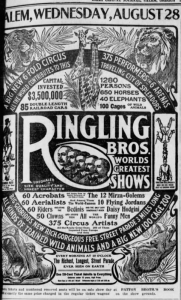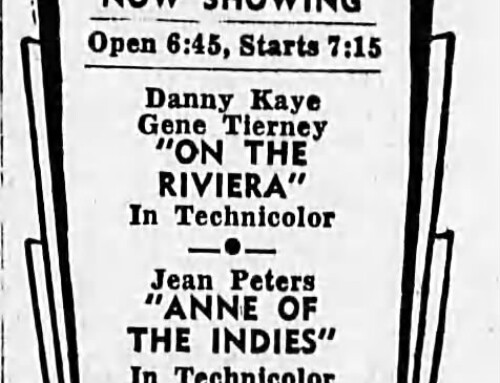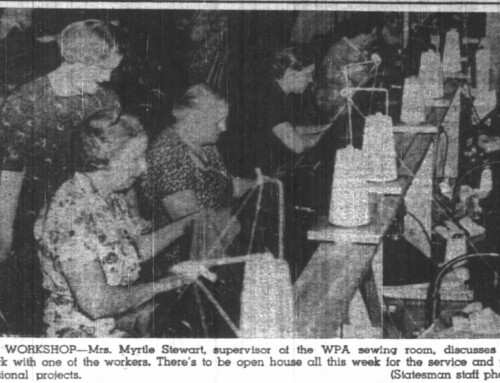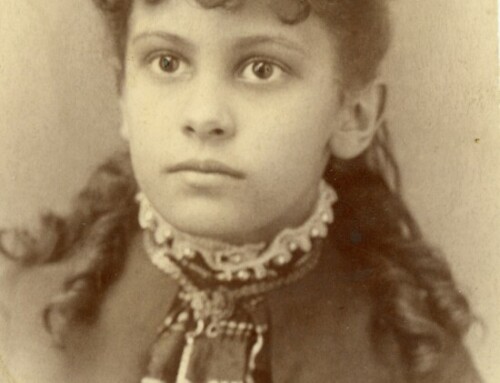On Wednesday, August 28, 1907 the “greatest show on earth” came to town. Ringling Brothers Circus, before they bought up Barnum and Bailey, were making the circuit of the Pacific Northwest with the longest circus train to date. Four special trains with twenty cars each. Oregon stops included Portland, Salem, Albany, Eugene, and Medford. And at each stop, like the Pied Piper of old, as the animals and people disembarked, the circus would put on a mesmerizing, thrilling, entertaining, and astounding parade that would attract people to the circus grounds where they could plunk down their quarters and fifty-cent pieces for a ticket to the Big Top. The parade was the circus’s most powerful form of advertising.
Citizens of Salem lined the parade route to watch the two mile extravaganza go by from its start at the freight depot on Front and Trade St., north on Commercial St., east on State St., and then north on Capitol St., slowly making its way over the course of an hour and a half, out to the state fairgrounds. The Capital Journal newspaper reported, “600 horses, a great herd of elephants, camels to spare, strange beasts in open dens, 1286 people, and hundreds of golden floats and tableaux vans passed the thousands on the sidewalks in a column at least two miles long.” Both the sights and the sounds of the circus parade were something to behold. The soft shuffling sound as dozens of elephants slid their sandpaper-like feet on the pavement; the clopping of 40 shod hooves as a ten-horse hitch passed by; the rattle of chains, the sudden roar of a lion.
The newspaper continued its report with the following details of the parade, “A calliope tooted “Everybody Works But Father,” cathedral chimes rang out “Auld Lang Syne” and a mounted band added march music to the strange melody. There were five other bands, one clown organization that murdered opus 924 of John Philip Sousa to the delight of the spectators – also a Colonial Yankee Doodle drum and fife corps in powdered wigs and George Washington hats, and a barbarian reed and tom-tom orchestra that suggested the Streets of Cairo. The parade was led by a troupe of buglers and a golden band chariot drawn by 24 white horses. Later on there was a “hitch” of 24 ponies, no larger than Kansas jack rabbits. There were any number of ten-horse teams, and many beautiful thoroughbreds driven tandem. It was a display of horseflesh that devotees of the track and stable well might rave over.”
One of the most interesting features of the parade was the elephants’ act. Each beast grasped the tail of the animal in front of him with his trunk and held on. Well ahead of the elephants a man on horseback rode by yelling “friends, secure your horses tightly the elephants are about to pass by.” A warning to which the owner of a certain team of horses pulling a wood wagon along Commercial St. should have given heed. Spooked by the roar of a tiger, the runaway team was stopped without harm to themselves or the crowd just a few blocks away on Court St. thanks to the efforts of two bystanders, Ray Gilbert and D. A. White.
Speaking of horses, let’s not forget one of the Ringling Brothers world renowned animal acts, Riccobono’s troup of trained horses. According to the Ringling Brothers circus program, “these equines wear boots, trousers, hats and coats; they dine at the table from plates; they take their own clothing off, even to the boots. One of these animals, known as the Good Night horse, lights a candle, makes his bed, takes off boots and coat, winds the clock, puts out the candle and goes to bed.”
And the babies, have we mentioned the dozen really interesting babies that accompanied the circus to town? According to the Oregonian newspaper, “They represent thousands of dollars, and are guarded like royalty. Their mothers are fiercely jealous of them, and ready to fight to the death to protect them. There are four sets of twins among them, which accounts for eight mothers of 12 babies. All are American born, but of foreign descent. They weigh from a few pounds to upwards of a ton apiece.”
The second section of the four circus trains contained the special animal nursery. These special babies are the star features in the menagerie of Ringling Brothers. “The families include Mrs. Tigress and three kittens, Mrs. Alice Elephant and offspring, Mrs. Peruvian Llama and Miss Llama, Miss Leopard and spotted little ones, Mrs. Lioness and roistering cubs, Mrs. Kangaroo and baby, Mrs. Hyena and youngster.”
After the last animal, wagon, and clown had passed by, the remaining crowd of thousands made a run on every place in the city where anything edible could be procured – hotels, restaurants, and grocery stores. The White House restaurant alone fed 2500 people within the span of a couple hours. Fights broke out in grocery stores over crackers, cheese, and bologna sausage. Bringing to mind the children’s song, “When the circus comes to our town, everybody acts like a clown. The world starts spinning upside down when the circus comes to town.”
This article was written by Kaylyn F. Mabey for the Statesman Journal where it was printed 20 September 2015. It is reproduced here for reference purposes.
References:
- Daily Capital Journal (Salem, Or.) – 9 Aug 1907
- Daily Capital Journal (Salem, Or.) – 14 Aug 1907
- Register Guard (Eugene, Or.) – 21 Aug 1907
- Daily Capital Journal (Salem, Or.) – 27 Aug 1907 – 29 Aug 1907
- Ringlingville USA: The Stupendous Story of Seven Siblings and Their Stunning Circus Success — by Jerry Apps



